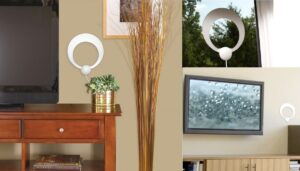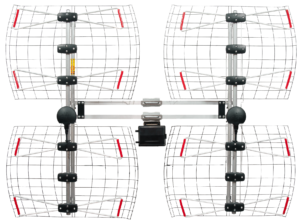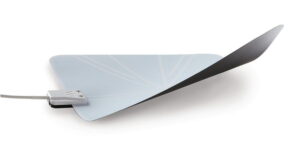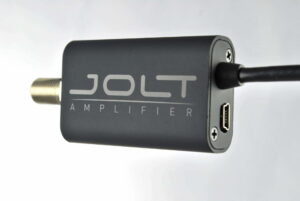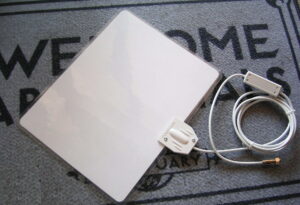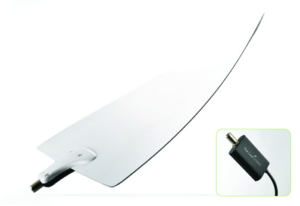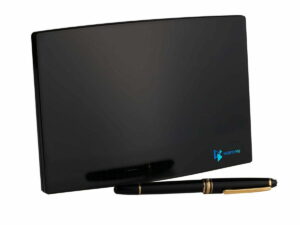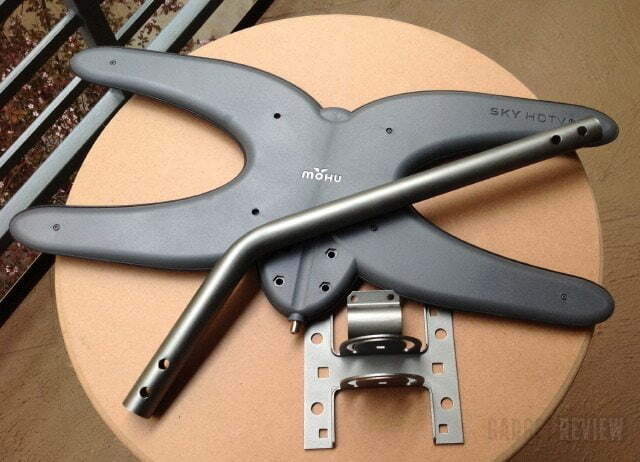
Are you looking for the best TV antenna? Having a TV antenna was once a requirement for watching television — pictures of houses in the 1950’s had vertical poles reaching up to the sky almost without exception. Today the main purpose of an antenna has been watered down, thanks to cable TV boxes and satellite receivers. However there are times when a stand-alone antenna isn’t just a novelty but a necessity: you have a TV in the backyard but no access to the cable box or don’t want to pay for another one. Fortunately, the broadcast networks are provided for free as is high-definition, provided the antenna can “pull” in the signal.” The mohu Sky HDTV Antenna can. Or, take a look at our Mohu Jolt antenna amplifier review to compare options.
The first factor to consider isn’t how to use an antenna, but how to position it. Not being a “tool geek,” I expect I’m at about the same level as anyone who isn’t that keen on learning a new skill-set. The Sky HDTV Antenna is fairly small and designed with a shape reminiscent of two right angle braces placed back to back and is about the width of two paperback books. It’s made of a lightweight composite metal that is trimmed with rubber on the edges — there’s no exposed wiring or controls — and obviously it can handle the elements since it’s for outdoor use. But “outdoor” doesn’t preclude an attic, and it’s here that I intend to try it out first (courtesy of a friend’s home). If you want an indoor antenna, check out our Mohus The Leaf Ultimate Amplified Indoor HDTV Antenna review.
Assembling the Sky HDTV Antenna took less than 10 minutes: the bottom of the antenna has a coaxial socket that the included 30 foot cable is screwed into (followed by a rubber stopper that waterproofs the connection). It’s possible to use it “as is” although some will opt for connecting it to the included mounting bracket, since then there’s a degree of angling control.
But one of the special things about this antenna is that it doesn’t need to be “angled” towards the signal — internal design makes that unnecessary. This is common amongst the highest rated indoor tv antennas. So rather than assembling the mounting bits, I placed the antenna horizontally in the attic with a few screws. Then it was just a matter of winding the cable down and over to the TV which is in the living room (if this was to be a permanent installation, time would be spent “fishing” the cable through the walls, rather than having it exposed).
The cable’s free end was then plugged into the included signal amplifier, with the short coaxial cable that is connected to the amplifier then screwed into the TV’s “Ant in.” The final step was to plug the included USB cable into the amplifier and then a USB socket for power — this will take up one of the TV’s USB ports that are typically found on the back. If there is no USB port, the included power adapter can be used instead (which is what I did).
Related: Also take a look at our Mohu Sky 60 Outdoor TV Antenna review.
The TV was turned on and the “Ant” input was selected. Then it was just a few minutes of waiting as the TV cycled through the channels so as to find those broadcast network signals that are both available and in sufficient signal strength for viewing. The broadcast towers were less than 50 miles away, so we didn’t expect not to be able to get a signal, and the Moho didn’t disappoint.
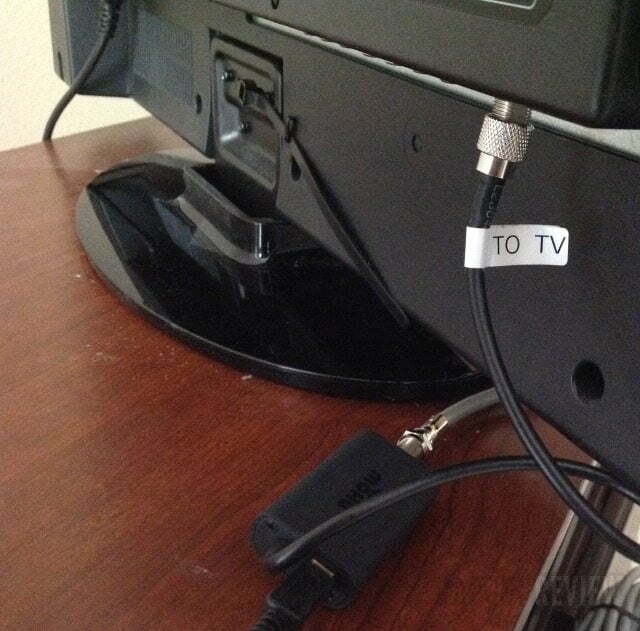
The results were HD broadcasts of all the local networks, like NBC and Fox and CBS. The images were clear, in high-definition and the sound was fine — routing the audio through the surround system connected to the TV didn’t display a hint of static or hiss. And of course the beauty of a digital TV signal is that you either get it or not — there’s none of that “ghosting” or other problems that could occur with an analog signal. And if you didn’t know that there was amplification involved, you wouldn’t think of it at all, since there wasn’t any interference in the image.
Now, since the mohu Sky HDTV Antenna is designated as an “outdoor” antenna, it was removed from the attic and repositioned on the outside wall, this time using the mounting equipment. The TV was then cycled again for the channels and the results were the same as they had been when the antenna had been in the attic. We also tried it inside the garage (used as a storage shed, actually), just to see if this would make any difference. Nope.
I’ll mention something obvious but important: do not mount the Sky HDTV Antenna so that it is anywhere near a power line or install it on a roof (or wall) whenever there’s a chance of lightning occurring. Other safety measures that involve being on a roof or in an attic apply as well.
Bottom line: The high-definition TV channels that the mohu Sky HDTV Antenna receives is as good as that acquired through a cable box/satellite receiver — plus it’s free. It’s an excellent choice for those with homes looking to save money without giving up any quality for viewing broadcast networks. The $169 retail is well spent.
Editor’s Rating:
[rating:4.5/5]
Excellent
Pros
- Powered amplification
- Multidirectional reception
Cons
- Mounting instructions could be a bit more simplified
Related Articles:
![10 Best Indoor TV Antennas in [year] 1 Best Indoor TV Antenna](https://www.gadgetreview.dev/wp-content/uploads/Best-Indoor-TV-Antenna-scaled-1-300x169.jpg)
![10 Best Long Range TV Antennas in [year] 2 Best Long Range TV Antenna](https://www.gadgetreview.dev/wp-content/uploads/Best-Long-Range-TV-Antenna-300x138.jpg)
![10 Best Omnidirectional TV Antennas in [year] 3 Best Omnidirectional TV Antenna](https://www.gadgetreview.dev/wp-content/uploads/Best-Omnidirectional-TV-Antenna-300x102.jpg)
![10 Best Rabbit Ear Antennas in [year] 4 Best Rabbit Ear Antenna](https://www.gadgetreview.dev/wp-content/uploads/Best-Rabbit-Ear-Antenna-300x169.jpg)
![10 Best RV Antennas in [year] 5 Best RV Antenna](https://www.gadgetreview.dev/wp-content/uploads/Best-RV-Antenna-300x180.jpg)
![10 Best TV Antenna Amplifiers in [year] 6 Best TV Antenna Amplifier](https://www.gadgetreview.dev/wp-content/uploads/Best-TV-Antenna-Amplifier-300x225.jpg)
